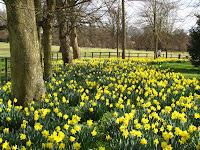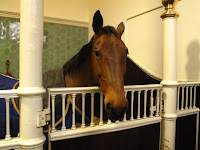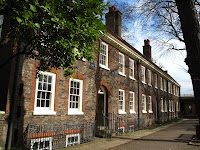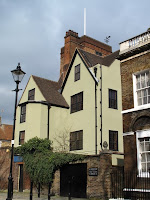
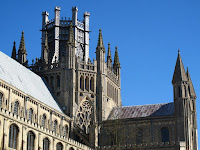
The whole of England was promised beautiful sunshine today, so we decided to do a circular driving tour passing through Ely, which is north of Cambridge. Dominating the town is the magnificent cathedral. Originally built on an island in the low lying swampy fens, it now appears to rise above the flat landscape of drained fields.

We enjoyed looking around the town, now adjacent to the River Great Ouse, then arrived at the cathedral to take in the service in the stunning surroundings. Being Sunday, admission to the cathedral was free, but we paid for a tour of the octagonal tower, This was very worthwhile, and gave us a different appreciation of the building.

From part way up the tower, we were able to get a birds eye view of the nave below. The tour highlight was a walk on the roof around the outside of the octagonal lantern. The views were amazing, especially on such a lovely day. We could see for miles, and the guide pointed out features 15 - 20 miles away.

The driving tour then took us through Soham, the town which featured a lot in the news a few years ago with the tragic murder of two schoolgirls. This seemed so out of character as it appeared such a quiet spot.
Then on to Swaffhams Prior past the Devil's Dyke. The ditch is an amazing medieval fortification which stretches for seven miles. The ditch is about 11m deep here, from the bottom of the ditch to the top of the bank.

The small village of Swaffhams Prior is equally interesting. Although quite small, it has two windmills at one end of the village and two churches within the same churchyard at the other end. Apparently the boundary for two parishes was between the two churches, and it took an act of parliament in 1667, to join the two parishes.

Our final stop was just down the road at a favourite winter garden – Angelsey Abbey. The winter garden must have suffered from the extreme weather this winter, as it didn't look as good as we have seen it other years. But the beautiful snowdrops in their woodland walk were a wonderful reminder that spring is nearly here.





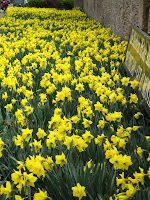 After the meeting, we drove to Blenheim Palace, which is nearby. The daffodils at Blenheim are coming out, and although they are looking wonderful, another week will have them looking absolutely stunning. Everything at Blenheim is almost larger than life, so we weren't disappointed at the large areas of daffodils. Even the private Italian gardens have an edging of daffodils around the formal box hedges.
After the meeting, we drove to Blenheim Palace, which is nearby. The daffodils at Blenheim are coming out, and although they are looking wonderful, another week will have them looking absolutely stunning. Everything at Blenheim is almost larger than life, so we weren't disappointed at the large areas of daffodils. Even the private Italian gardens have an edging of daffodils around the formal box hedges.